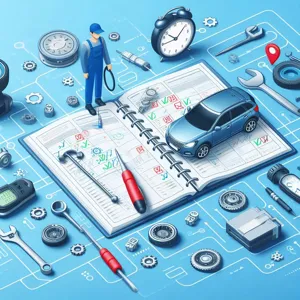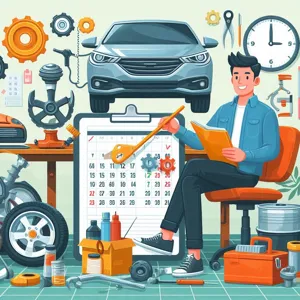In our fast-paced world, where juggling work commitments, family responsibilities, and personal pursuits often leaves little room for anything else, car maintenance can easily slip down the priority list.
Yet, keeping your vehicle in top shape is essential—not just for safety but also for ensuring it runs smoothly and efficiently. This blog post, “Mastering Car Care: efficient Maintenance Tips for Busy Lives,” is designed for those who want to maintain their vehicles without sacrificing precious time. We’ll explore practical and time-saving strategies that fit seamlessly into your busy schedule, from quick inspection routines to essential DIY maintenance tasks. Whether you’re a seasoned car owner or a first-time driver, these tips will empower you to take control of your car care, ensuring that your vehicle remains reliable and ready for any adventure that comes your way. Let’s dive in and discover how easy it can be to keep your car in prime condition, no matter how hectic life gets!
1. Introduction to Car Care: Why It Matters

In today’s fast-paced world, where time often feels like a luxury, the importance of car care can easily be overshadowed by our busy schedules. However, understanding the significance of regular maintenance for your vehicle is crucial—not just for the longevity of the car itself, but also for your safety and financial well-being. A well-maintained vehicle runs more efficiently, consumes less fuel, and is less prone to unexpected breakdowns. This means fewer trips to the mechanic and a lower likelihood of costly repairs down the line.
Moreover, maintaining your car can enhance its resale value, making it a smart investment in the long run. Regular upkeep gives you peace of mind, knowing that your car is in optimal condition to handle everything from daily commutes to long road trips. Beyond the practical benefits, taking the time to care for your car can also foster a deeper connection to your vehicle, transforming it from just a mode of transportation into a trusted companion on your daily adventures.
In this blog post, we’ll dive into essential car maintenance tips that fit seamlessly into your bustling life, ensuring that you can keep your vehicle in top shape without feeling overwhelmed. Whether you’re a seasoned car enthusiast or a first-time owner, mastering these efficient maintenance practices will empower you to take control of your car care routine, making it manageable and effective. Let’s embark on this journey to discover how a little attention today can lead to a safer and more reliable driving experience tomorrow.
2. Understanding Your Vehicle’s Maintenance Schedule
Understanding your vehicle’s maintenance schedule is crucial for keeping your car in peak condition, especially when life gets busy. Every vehicle comes with a unique maintenance schedule outlined in the owner’s manual, detailing when specific services are needed—from oil changes and tire rotations to brake inspections and battery checks. This schedule is not merely a suggestion; it’s a roadmap designed to ensure your vehicle performs optimally and lasts longer.
Begin by familiarizing yourself with the recommended intervals for routine maintenance, which are typically categorized by mileage or time. For instance, many manufacturers suggest an oil change every 5,000 to 7,500 miles, but this can vary based on your driving habits and the type of oil used. Keeping a log of your maintenance activities can help you stay organized and ensure you don’t overlook essential services.
In our fast-paced lives, it’s easy to push car care to the bottom of our to-do lists. However, neglecting scheduled maintenance can lead to more significant issues down the line, resulting in costly repairs and extended downtime. To simplify this process, consider setting calendar reminders for each service due date, or use mobile apps that track your vehicle’s maintenance needs and alert you when action is required.
Understanding and adhering to your vehicle’s maintenance schedule not only saves you time and money but also enhances your driving experience. A well-maintained car is a reliable companion, providing peace of mind on the road, whether you’re commuting to work, running errands, or embarking on weekend adventures. Prioritizing this aspect of car ownership can truly make a difference in how you navigate your busy life.
3. Essential Tools Every Car Owner Should Have

When it comes to car care, having the right tools on hand can make all the difference in keeping your vehicle running smoothly and efficiently. For busy lives, where time is of the essence, investing in essential tools allows for quick maintenance checks and minor repairs without the hassle of frequent trips to the mechanic. Here’s a list of must-have tools that every car owner should consider adding to their garage or trunk.
**1. Tire Pressure Gauge:** Maintaining the correct tire pressure is crucial for both safety and fuel efficiency. A simple tire pressure gauge can help you monitor tire health regularly. Digital gauges offer quick readings, while traditional analog types are equally effective—just choose what feels best in your hand.
**2. Jumper Cables:** A dead battery can happen at the most inconvenient times. Having a set of reliable jumper cables can save you—and others—when a boost is needed. Look for heavy-duty cables that can handle multiple jump-starts, and ensure they are stored in an accessible place.
**3. Socket Set and Wrenches:** A versatile socket set paired with an adjustable wrench is essential for tackling a variety of maintenance tasks, from changing oil to replacing spark plugs. Make sure to have a set that includes multiple sizes to accommodate different bolts and fittings.
**4. Screwdriver Set:** A quality screwdriver set, complete with both flathead and Phillips heads, is indispensable for any car owner. These tools will come in handy for tightening loose screws, removing panels, or making small adjustments.
**5. Oil Filter Wrench:** If you’re planning to perform your own oil changes, an oil filter wrench is a must. This tool provides the necessary grip to remove old filters with ease, making the oil change process much smoother.
**6. Flashlight or Work Light:** Adequate lighting is essential when working on your car, especially in low-light conditions. A sturdy, rechargeable flashlight, or a portable work light, can help illuminate hard-to-see areas, making maintenance tasks safer and more efficient.
**7. Emergency Kit:** While not a tool in the conventional sense, a well-stocked emergency kit is vital for any car owner. Include items such as first-aid supplies, a reflective triangle, flares, and basic tools. This kit will prepare you for unexpected situations and provide peace of mind during your travels.
By equipping yourself with these essential tools, you’ll be well-prepared to tackle routine maintenance and handle unexpected challenges that arise. Not only will this save you time and money, but it will also give you confidence in your ability to care for your vehicle, ensuring it remains reliable in your busy life.
4. Quick Checks: How to Inspect Your Car in Under 10 Minutes
In our fast-paced lives, finding time to maintain our vehicles can feel like a daunting task. However, mastering car care doesn’t have to consume your entire weekend. With just a few quick checks, you can ensure that your vehicle stays in optimal condition, all in under 10 minutes.
Start by gathering your tools: a tire pressure gauge, a flashlight, and a microfiber cloth will be your best friends in this rapid inspection. First up, tires. Take a moment to visually inspect each tire for any signs of wear or damage. Look for uneven tread wear, bulges, or foreign objects lodged in the rubber. Next, use your tire pressure gauge to check the air pressure, making sure each tire is inflated to the manufacturer’s recommended levels, typically found on the driver’s side door jamb. Proper tire pressure not only enhances safety but also improves fuel efficiency.
Moving on, pop the hood and take a quick glance at the engine bay. Check the oil level using the dipstick; a quick wipe and re-insertion will tell you if it’s time for an oil change. If your vehicle has a translucent coolant reservoir, ensure that the fluid is at an appropriate level. A quick check of the battery terminals for corrosion can also save you from a surprise breakdown.
Finally, don’t overlook the lights. Turn on your headlights and hazard lights, stepping outside to visually confirm that all bulbs are functioning. Also, take a moment to clean your windshield and check the wiper blades for any signs of wear. A clear view is crucial for safe driving, and replacing wipers is a simple task that can be done in minutes.
By dedicating just 10 minutes to these essential checks, you can catch minor issues before they escalate and keep your vehicle running smoothly. This efficient approach to car maintenance not only saves you time in the long run but also gives you peace of mind as you navigate your busy life.
5. The Importance of Regular Oil Changes

When it comes to car maintenance, one of the most crucial yet often overlooked tasks is the regular oil change. Think of your vehicle as a finely-tuned machine; just like any machine, it requires proper lubrication to function smoothly. Engine oil plays a vital role in this process, reducing friction between moving parts, keeping them cool, and preventing corrosive damage. Neglecting to change your oil regularly can lead to a cascade of problems, from decreased fuel efficiency to severe engine damage, ultimately costing you much more in repairs than the simple act of maintaining your oil.
For busy individuals, it can be easy to push oil changes to the bottom of the to-do list, but establishing a routine can save time and trouble down the line. Most manufacturers recommend changing your oil every 3,000 to 5,000 miles, but newer engines and synthetic oils can stretch that to 7,500 miles or more. Keeping track of your vehicle’s mileage and setting reminders in your calendar or smartphone can ensure you never miss a change.
Additionally, many oil change services offer quick and convenient solutions to fit your hectic schedule, often taking less than an hour. Some companies even provide mobile services that come directly to your home or workplace, making it easier than ever to prioritize your car’s health without interrupting your day. By staying on top of your oil changes, you’ll not only extend the life of your engine but also enjoy a smoother, more efficient ride, allowing you to focus on the demands of your busy life without worry.
6. Tire Maintenance: Tips for Longevity and Performance
When it comes to car care, tire maintenance is often overlooked, yet it plays a crucial role in ensuring both longevity and performance. Your tires are the only point of contact between your vehicle and the road, making their condition paramount for safety and efficiency. For those leading busy lives, implementing a few simple tire maintenance tips can save time, money, and hassle in the long run.
First and foremost, regular tire pressure checks are essential. Under-inflated tires not only reduce fuel efficiency but also wear out more quickly and can compromise safety. Invest in a good tire pressure gauge and make it a habit to check your tire pressure at least once a month, or before long trips. Most vehicles have a recommended tire pressure listed on the driver’s side door jamb, making it easy to stay informed.
Next, ensure you rotate your tires regularly. Tire rotation involves moving the tires from one position to another to promote even wear. This is especially important for front-wheel-drive vehicles, where the front tires often wear out faster. A general rule of thumb is to rotate your tires every 5,000 to 7,500 miles, or every other oil change. This simple step can significantly extend the life of your tires.
Another vital aspect of tire maintenance is monitoring tread depth. Adequate tread depth is crucial for optimal traction and handling, particularly in wet or slippery conditions. You can easily check tread depth using the penny test: insert a penny into the tread with Lincoln’s head facing down. If you can see the top of Lincoln’s head, it’s time to replace your tires. Many tire shops offer free tread depth checks, so don’t hesitate to take advantage of this service.
Lastly, don’t forget about wheel alignment. Misalignment can lead to uneven tire wear and negatively impact your vehicle’s handling. If you notice your steering wheel pulling to one side or your tires wearing unevenly, it may be time for an alignment check. Regular alignment checks, typically recommended every 6,000 miles or when you hit a significant pothole, will help maintain your tires’ performance and longevity.
By incorporating these tire maintenance tips into your routine, you can ensure that your tires are not only safe but also provide the best performance possible. So take a moment from your busy schedule to give your tires the attention they deserve; your vehicle and your wallet will thank you in the long run.
7. Keeping Your Battery Healthy: Signs of Wear and Replacement Tips

Maintaining a healthy car battery is crucial for ensuring your vehicle runs smoothly, especially in our busy lives where we rely heavily on our cars. A battery failure can lead to inconvenient delays and unexpected costs, making it essential to be proactive about battery care.
One of the first signs of a weakening battery is sluggishness when starting your engine. If you notice that your car takes longer to crank or the headlights dim when you turn the ignition, it may be time to investigate further. Additionally, check for any corrosion around the battery terminals, which can hinder performance and affect the battery’s lifespan. A buildup of white, ashy residue can often indicate that your battery is under strain and may need replacement.
Another important factor to consider is the age of your battery. Most car batteries have a lifespan of about three to five years, depending on usage and environmental conditions. If your battery is nearing this age, it’s wise to have it tested regularly, even if you haven’t noticed any significant issues.
To keep your battery in optimal condition, ensure that it is securely mounted in place, as vibrations from driving can lead to physical damage over time. Additionally, regular cleaning of the terminals and connections will prevent corrosion and improve conductivity.
When it comes time for a replacement, invest in a high-quality battery that meets your vehicle’s specifications. Don’t forget to recycle your old battery responsibly—most auto shops offer recycling services. By staying vigilant and addressing any signs of battery wear promptly, you can extend the life of your battery and keep your vehicle running smoothly, all while fitting car care into your busy schedule.
8. Efficient Cleaning: Exterior and Interior Care in Less Time
In today’s fast-paced world, finding time for car maintenance can feel like an uphill battle, especially when it comes to keeping your vehicle looking pristine both inside and out. However, with some strategic planning and efficient cleaning techniques, you can achieve a spotless car without sacrificing your precious time.
**Exterior Care in a Snap**
Start with a quick rinse to remove loose dirt and debris. A pressure washer or a hose with a spray nozzle can speed this up significantly. Next, opt for a two-bucket wash method: one bucket for soapy water and another for rinsing your sponge or mitt. This not only saves time but also helps prevent swirl marks on your paint. Choose a quick-drying soap that also contains wax for added shine without the extra effort. If possible, consider using a foam cannon; this tool covers your car with suds in seconds, allowing you to let the soap sit while you tackle the interior.
To dry your car efficiently, invest in a microfiber drying towel or a chamois, which can absorb water quickly and leave no streaks behind. For that polished look, a spray-on wax can be applied after drying — it’s a time-saver that adds a layer of protection and shines in seconds.
**Interior Care Made Easy**
Moving to the interior, keeping your car organized is key to a quick clean. Use easy-to-access organizers for essentials like sunglasses, charging cables, and snacks. This simple step makes tidying up a breeze. For a thorough clean, try a handheld vacuum with attachments to reach tight spaces, like between seats and in cup holders.
When it comes to surfaces, a multipurpose cleaner can save you time and effort. Spray it on a microfiber cloth and wipe down all surfaces — from the dashboard to the door panels — in one go. Don’t forget to clean your floor mats; if they’re rubber, a quick rinse will do, while cloth mats can be shaken out and vacuumed for a deep clean.
For those busy days when you’re just too rushed, consider a detailing service that can come to you. This saves you time while ensuring your vehicle remains in top condition. With these efficient cleaning tips, you can maintain the beauty of your car without the stress, leaving you more time to enjoy the road ahead.
9. Seasonal Maintenance: Preparing Your Car for Winter and Summer
Seasonal maintenance is essential for keeping your vehicle in peak condition throughout the year, especially when transitioning between the harsh conditions of winter and the sweltering heat of summer. Neglecting this crucial aspect of car care can lead to unexpected breakdowns and costly repairs, which is the last thing anyone wants in an already busy life.
As winter approaches, it’s vital to prepare your car for the challenges that come with icy roads and frigid temperatures. Start by checking your battery, as cold weather can sap its power and lead to starting issues. Inspect your antifreeze levels and ensure your windshield wipers are in good condition, as visibility is crucial during snowy conditions. Don’t forget to switch to winter tires for enhanced traction, and keep a winter emergency kit in your trunk, complete with blankets, a flashlight, and non-perishable snacks.
On the other hand, when summer rolls in, the heat can take a toll on your vehicle’s performance. Begin by checking your coolant levels to prevent overheating, and inspect your air conditioning system to ensure it’s functioning properly—there’s nothing worse than a sweaty drive on a hot day! It’s also a good time to replace your wiper blades and inspect your tires for wear, as the heat can exacerbate existing damage.
Incorporating seasonal maintenance into your routine not only extends the lifespan of your vehicle but also provides peace of mind as you navigate your busy life. By staying proactive, you can ensure that your car is ready to handle whatever the seasons throw your way, allowing you to focus on what truly matters.
10. Fuel Efficiency Tips for Busy Drivers
In today’s fast-paced world, where every minute counts and errands seem to multiply, busy drivers often overlook one crucial aspect of car ownership: fuel efficiency. However, incorporating a few simple habits can significantly enhance your vehicle’s mileage, saving you time and money in the long run.
First and foremost, maintaining proper tire pressure is essential. Under-inflated tires can increase rolling resistance, causing your engine to work harder and consume more fuel. Make it a habit to check your tire pressure regularly, ideally once a month or before long trips.
Next, consider your driving habits. Aggressive driving, characterized by rapid acceleration and hard braking, not only endangers your safety but also guzzles fuel. Instead, adopt a smoother driving style. Gradual acceleration and gentle braking can improve your fuel economy by up to 30%. When possible, use cruise control on highways to maintain a constant speed, which optimizes fuel usage.
Another effective strategy is to eliminate excess weight from your vehicle. Every additional pound requires more energy to move, so take a moment to declutter your car. Remove any unnecessary items from the trunk and backseat, and even consider removing roof racks when not in use, as they can create aerodynamic drag.
Finally, plan your trips efficiently. Combine errands to reduce the number of short, cold starts, which consume more fuel. Use navigation apps to find the quickest routes and avoid congested areas, saving both time and gas.
By adopting these fuel efficiency tips, busy drivers can manage their fuel consumption with ease, allowing them to focus on what matters most in their hectic lives while ensuring their vehicles run optimally. Embrace these practices, and you’ll not only keep your car in great shape but also enjoy the added bonus of fewer trips to the gas station.
11. How to Stay on Top of Recalls and Service Bulletins
Staying informed about vehicle recalls and service bulletins is crucial for maintaining the safety and performance of your car, yet it often falls by the wayside in our busy lives. Fortunately, there are efficient ways to keep yourself updated without overwhelming your schedule.
First, familiarize yourself with the National Highway Traffic Safety Administration (NHTSA) website, which is a treasure trove of information. By simply entering your Vehicle Identification Number (VIN), you can quickly check for any recalls specific to your make and model. Setting a reminder to check this site every few months can keep you in the loop without needing to remember every detail.
Another proactive approach is to subscribe to notifications from your car manufacturer. Many brands offer email alerts that will inform you about recalls, service bulletins, and even maintenance tips tailored to your vehicle. This way, you receive updates directly in your inbox, allowing you to act promptly if your vehicle is affected.
Furthermore, consider downloading mobile apps designed for car care and maintenance. These apps can track your vehicle’s service history, remind you of due maintenance, and alert you about recalls based on your VIN. With notifications sent straight to your phone, you can keep your car’s health at the forefront of your mind without adding extra tasks to your to-do list.
Lastly, don’t underestimate the power of your local dealership or service center. Establishing a relationship with them can provide you with additional insights into any service bulletins or recalls that may not be widely publicized. Regular check-ins during oil changes or tire rotations allow you to stay informed while ensuring your vehicle is in top shape.
By integrating these simple strategies into your routine, you can effortlessly stay on top of recalls and service bulletins, ensuring that your vehicle remains safe and reliable—all while managing your busy life.
12. Utilizing Technology: Car Care Apps and Reminders
In today’s fast-paced world, where every minute counts, technology has come to the rescue for car owners looking to streamline their maintenance routines. Car care apps and digital reminders can transform the daunting task of vehicle upkeep into a manageable and efficient process.
Imagine having a personal assistant right in your pocket, ready to alert you when it’s time for your next oil change, tire rotation, or inspection. With a myriad of car care apps available, you can track your vehicle’s maintenance history, monitor fuel consumption, and even receive alerts for upcoming service appointments. These apps often allow you to input your vehicle’s make and model, tailoring reminders specifically to your car’s needs, ensuring you never miss a crucial maintenance task.
Many apps also provide handy features, such as locating nearby service centers, comparing prices, and reading reviews from other users. This not only saves you time but also helps you make informed decisions about where to take your vehicle for maintenance or repairs. Furthermore, some apps can even offer DIY tips for simple tasks, empowering you to handle minor issues without the hassle of scheduling a service appointment.
In addition to car care apps, leveraging calendar reminders on your smartphone can keep you organized. Set recurring reminders for routine inspections, registration renewals, and emissions tests. By integrating these reminders into your daily schedule, you can ensure that car maintenance becomes a seamless part of your life rather than a stressful afterthought.
Embracing technology in your car care routine not only enhances efficiency but also prolongs the life of your vehicle, ultimately saving you money in the long run. By utilizing car care apps and setting digital reminders, you can enjoy peace of mind, knowing that your vehicle is always in top shape, even amidst your busy lifestyle.
13. DIY vs. Professional Services: When to Choose Each
When it comes to car maintenance, the age-old debate of DIY versus professional services often leaves many drivers scratching their heads. In our fast-paced lives, understanding when to roll up your sleeves and tackle a task yourself, versus when to hand over the keys to a professional, can save you time, money, and a whole lot of stress.
DIY car care can be an incredibly rewarding experience, particularly for minor tasks that don’t require extensive technical knowledge or specialized tools. Simple procedures like changing your oil, replacing air filters, or rotating your tires can be tackled with a little research and some basic equipment. Not only does this save you money on labor costs, but it also gives you a sense of accomplishment and a deeper understanding of your vehicle. For those who enjoy hands-on work, DIY maintenance can be a therapeutic way to connect with your car.
However, there are times when the expertise of a professional is invaluable. If you’re facing complex issues like engine problems, brake repairs, or electrical system failures, it’s wise to consult a certified mechanic. These professionals have the training, experience, and diagnostic tools necessary to identify and fix issues that may not be immediately apparent. Attempting to tackle these kinds of repairs on your own can often lead to further complications, not to mention safety risks.
Additionally, consider your own schedule and comfort level. If you lead a busy life, dedicating your precious free time to car repairs might not be feasible or enjoyable. In such cases, investing in professional services can provide peace of mind and allow you to focus on what truly matters in your life.
Ultimately, the decision between DIY and professional services hinges on the specific task at hand, your skill level, and your available time. By evaluating these factors, you can ensure that your vehicle receives the proper care it deserves, keeping it running smoothly while fitting seamlessly into your busy lifestyle.
14. Creating a Car Care Routine That Fits Your Schedule
Creating a car care routine that fits your schedule is essential for maintaining your vehicle’s health without adding stress to your busy life. The key is to integrate car maintenance seamlessly into your existing routine rather than treating it as a separate, daunting task. Start by identifying the most convenient times for you—perhaps during your weekly grocery run or right after your regular trip to the gym.
Begin with a simple checklist that outlines essential tasks, such as checking tire pressure, oil levels, and fluid reservoirs. Aim to tackle these checks on a bi-weekly basis, aligning them with your existing errands. For instance, while you’re waiting for your coffee to brew at home, take a few moments to glance at your tire tread or inspect your windshield wipers.
Additionally, consider setting reminders on your phone for maintenance tasks that require more time, like scheduling an oil change or rotating your tires. By establishing a recurring calendar event every three months for these services, you can ensure they don’t slip through the cracks.
Don’t forget to take advantage of technology. Numerous apps can help you keep track of your car’s maintenance schedule, reminding you of upcoming service needs and even connecting you with nearby service providers.
Lastly, involve your family in the routine. Designate a “car care day” once a month where everyone pitches in, whether it’s washing the car, vacuuming the interior, or checking essential fluid levels. This not only lightens your workload but also instills a sense of shared responsibility and pride in your vehicle.
By crafting a car care routine tailored to your busy life, you’ll not only prolong the lifespan of your vehicle but also enjoy peace of mind knowing you’re taking proactive steps to keep it running smoothly.
15. Conclusion: The Benefits of Proactive Car Maintenance
In conclusion, embracing a proactive approach to car maintenance can significantly enhance your driving experience, save you time, and ultimately protect your investment. By staying ahead of potential issues, you not only ensure that your vehicle runs smoothly but also increase its longevity and reliability. Regular check-ups and timely interventions can help you avoid the stress and expense of unexpected repairs, giving you peace of mind whether you’re commuting to work, embarking on a road trip, or simply running errands.
Moreover, a well-maintained vehicle contributes to better fuel efficiency and performance, allowing you to enjoy a more responsive driving experience while saving money at the pump. Proactive car care also enhances safety on the road, reducing the risk of breakdowns and accidents caused by neglected components.
By integrating simple maintenance habits into your routine—like regular oil changes, tire rotations, and fluid checks—you can keep your car in top shape without overwhelming your busy schedule. Remember, investing just a little time and effort into your car’s upkeep can lead to a smoother, safer, and more enjoyable ride for years to come. So, take charge of your car care today and reap the long-term benefits of a well-maintained vehicle!
In conclusion, mastering car care doesn’t have to be a time-consuming endeavor, even for those with the busiest of schedules. By implementing the efficient maintenance tips outlined in this post, you can keep your vehicle in top shape without sacrificing your valuable time. From creating a simple maintenance schedule to utilizing the right products and services, these strategies empower you to take control of your car’s health while juggling daily responsibilities. Remember, a well-maintained vehicle not only enhances your driving experience but also ensures your safety on the road. As you embark on your car care journey, embrace the peace of mind that comes with knowing you’re doing your best to preserve your investment. Happy driving, and may your journeys be smooth and worry-free!
































